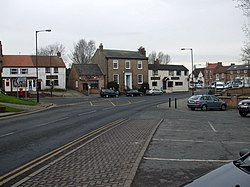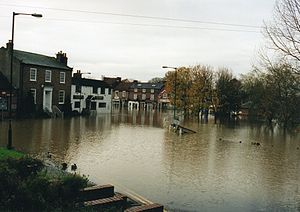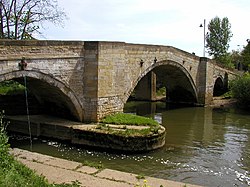Difference between revisions of "Stamford Bridge"
(Created page with "{{Infobox town |county=York |riding=East |latitude=53.989 |longitude=-0.912544 |population=3,528 |census year=2011 |LG district=East Riding of Yorkshire |constituency=East Yor...") |
(→The bridge) |
||
| Line 76: | Line 76: | ||
===The bridge=== | ===The bridge=== | ||
[[File:The road bridge at Stamford Bridge over the River Derwent.jpg|thumb|250px|The road bridge over the River Derwent]] | [[File:The road bridge at Stamford Bridge over the River Derwent.jpg|thumb|250px|The road bridge over the River Derwent]] | ||
| − | There has been a river crossing since at least Roman times. The river 275 yards upstream of the current bridge was passable except at times of flood via a natural rock ford. There was a bridge at or near the village in the 11th century as one is referred to in accounts of the battle of 1066, noted in the Anglo-Saxon Chronicle, Manuscript 'C'. Archaeological research has shown that there was a bridge crossing of the River Derwent one mile | + | There has been a river crossing since at least Roman times. The river 275 yards upstream of the current bridge was passable except at times of flood via a natural rock ford. There was a bridge at or near the village in the 11th century as one is referred to in accounts of the battle of 1066, noted in the Anglo-Saxon Chronicle, Manuscript 'C'. Archaeological research has shown that there was a bridge crossing of the River Derwent one mile south of the present village which linked the east and west bank of the Roman settlement of Derventio. |
In the mediæval period a new bridge made of timber supported on three stone piers was erected. Records show that this was repaired in the 13th and 16th centuries. A map from 1724 shows this bridge to have been 70 yds upstream from the current bridge. | In the mediæval period a new bridge made of timber supported on three stone piers was erected. Records show that this was repaired in the 13th and 16th centuries. A map from 1724 shows this bridge to have been 70 yds upstream from the current bridge. | ||
Revision as of 11:05, 8 December 2019
| Stamford Bridge | |
| Yorkshire East Riding | |
|---|---|
 Village Centre | |
| Location | |
| Grid reference: | SE710550 |
| Location: | 53°59’20"N, 0°54’45"W |
| Data | |
| Population: | 3,528 (2011) |
| Post town: | York |
| Postcode: | YO41 |
| Dialling code: | 01759 |
| Local Government | |
| Council: | East Riding of Yorkshire |
| Parliamentary constituency: |
East Yorkshire |
Stamford Bridge is a village and civil parish in Yorkshire on the River Derwent, approximately five miles east of York and 22 miles west of Driffield. The village lies on the borders of the East Riding and North Riding.
Contents
Location and history
The village sits astride an ancient ford on the River Derwent.
The Romans established a fort here about AD 70, around which later developed a large linear civilian settlement focused on a bridge one mile south of the present town. Iter I of the Antonine Itinerary lists "Derventio" as being seven Roman miles from Eboracum (York) which matches the distance from York. In relation to known discoveries under the town of Malton, antiquaries always assumed that Malton should be called Derventio. The remains at Stamford Bridge were not known to them, lying undiscovered under arable and pasture fields until quite recently.
The Battle of Stamford Bridge on 25 September 1066 is the traditional end of the Viking era in Britain. In this battle Harold Godwinson repelled the invading Norwegian force led by his brother Tostig Godwinson and King Harald Hardrada of Norway - but three weeks later his loss at the Battle of Hastings allowed the Norman conquest.
The settlement was called Pons Belli by the Normans, meaning battle bridge. Rents of freeholders and cottagers were recorded in 1368 and there was a common oven recorded the same year.
The A166 east-west road crossing the river at Stamford Bridge is one of the main roads from York to the East Riding and the coast. The road bridge in the village was closed on 5 March 2007, for just over 11 weeks, so that essential repairs could be carried out, in light of the enormous volume of traffic that uses it, exceptional for such an old bridge (dating from 1727). The bridge re-opened on 22 May.
In 1882 the population was 449; in the 2011 UK census the parish population was 3,528,[1] an increase on the 2001 UK census figure of 3,394.[2]
The village suffered from record floods in November 2000 which seriously flooded 30 businesses and homes. Flood defences have now been installed, costing £3.7 million.
The history of Stamford Bridge is covered in British History Online: Catton Kexby, Scoreby, and Stamford Bridge West,[3] and Catton High and Low Catton and Stamford Bridge East.[4]
Natural history
Flooding
The River Derwent divides Stamford Bridge into two. It rises in the North York Moors and flows south-west rather than taking a direct route to the North Sea. It eventually joins the River Ouse north of the village of Long Drax, before flowing ultimately into the Humber Estuary.
During 4/5 March 1999, exceptional levels of rainfall were experienced in the Derwent catchment area, reaching five inches inside a 24‑hour period. The situation was worsened by melting snow which had earlier accumulated on the North York Moors.
The conditions deteriorated and by Sunday 7 March large areas of Stamford Bridge were under water and a final flooding depth of approximately five feet was recorded by Monday 8 March.
At the height of the flooding the River Derwent reach the peak of 16 ft above its normal level, the highest level ever recorded exceeding the previous highest in 1931 by some 20 inches.
However, the following year a new record flood level was set. In October 2000 the Derwent again burst its banks and peaked slightly above the 1999 flood level.
Work started in autumn 2003 to build new flood defences for Stamford Bridge and in autumn 2004, work on the defences were finished.[5]
The flood defences were breached, and much of the village square was under water, on the morning of 26 June 2007, in the wake of exceptional rainfall over the previous 24 hours.
Landmarks
Stamford Bridge has several notable landmarks, including the Corn Mill; the stone arched bridge over the River Derwent; the Stamford Bridge Viaduct,[6] and Stamford Bridge railway station, both circa 1847;[7] a Wesleyan Methodist Chapel, built 1828 in yellow brick;[8][9] the Bay Horse Inn, late 18th to early 19th century public house;[10] as well as "Derwent Plastics factory", on the west side of the river, established in 1934 from a former brewery building; and a memorial commemorating the Battle of Stamford Bridge overlooking the field where the battle is thought to have taken place.
Just east of Stamford Bridge is the manor house Burtonfields Hall, built in 1837 by the architect Anthony Salvin for Charles Darley. Darley was married to Salvin's sister-in-law Marianne Nesfield, and their daughter married Anthony Salvin Junior. The original house was extended by W H Brierley in about 1898.
The mill
The Cornmill is a late 18th- to early 19th-century Grade-II-listed water mill.[11]
The current mill was possibly expanded in 1847–50 when nearly £1,000 was spent on it. Subsequently, there were two water wheels and seven pairs of grinding stones. The mill ceased operation in 1964 and was converted into a restaurant in 1967. More recently the Cornmill was converted into twelve two-bedroom apartments but some of the original equipment remains.
The bridge
There has been a river crossing since at least Roman times. The river 275 yards upstream of the current bridge was passable except at times of flood via a natural rock ford. There was a bridge at or near the village in the 11th century as one is referred to in accounts of the battle of 1066, noted in the Anglo-Saxon Chronicle, Manuscript 'C'. Archaeological research has shown that there was a bridge crossing of the River Derwent one mile south of the present village which linked the east and west bank of the Roman settlement of Derventio.
In the mediæval period a new bridge made of timber supported on three stone piers was erected. Records show that this was repaired in the 13th and 16th centuries. A map from 1724 shows this bridge to have been 70 yds upstream from the current bridge.
In the 18th century the weir and the by-pass canal and lock, known as the New Cut, were built and the medieval bridge was replaced with the current structure.
The present bridge was designed by William Etty under an Act of 1725 and completed in 1727. The bridge was strengthened in the 1960s and at the same time the adjacent pedestrian bridge was erected.[12]
The bridge is a Grade-II* listed monument.[13]
The viaduct
- Main article: Stamford Bridge Viaduct
Opened on 3 October 1847, the viaduct originally carried the York to Beverley railway line across the Derwent, closed 1965. It consists of red brick arches on either side of a single wider wrought-iron span that crosses the river. The viaduct now forms part of a public cycle route, and is Grade-II* listed.[14]
Education
The village school was first built in Main Street in 1795 as a result of a legacy left by Christopher Wharton. Education was provided free for 12 poor boys and 6 poor girls who had to provide one shilling a year for kindling. Pay scholars were also taught and by 1822 the school population numbered 30. 1874 saw compulsory education and in 1911 the East Riding Council took over and built a school on the present Church Road site.
This original building was modernised and extended in 1968 and because of the rapid development of the village a further extension was added in 1978. In April 1983 a new infants building, in Godwinsway, Stamford Bridge, was added to the school. Built for 120 infant children it makes the school a split site establishment, but adds greatly to the educational provision for the children. In 2000 this building was also extended.
Commerce
Even though the journey from York to the North Sea coast is just an hour, Stamford Bridge remains a popular stopping point for travellers on the A166. Most stops are for refreshment, usually required due to the long queues to get over the one lane bridge, at one of the establishments located around the Square.
The facilities located in central Stamford Bridge include:
- Post office and solicitors
- Estate agent
- Convenience store, a butcher/baker and a pharmacist
- Caravan park
- Nursing home
- Three pubs, the Three Cups, the New Inn (previously known as the Swordsman, but the name was changed back to its original name February 2013) which both provide food and the Bay Horse.
- A bistro
- A tea room and village shop
- An old style sweet shop complete with a Barbers shop in the rear.
- Fast food which is served by a pizza/kebab shop, a fish and chip shop, a Chinese restaurant/take-away, Indian restaurant/take-away and a sandwich shop
- Modern purpose built veterinary clinic, a dental practice and a doctor's surgery
- Two car repair garages
- Specialist whisky shop
- An shop specialising in eclectic and unusual items.
- Hairdressing salon and a beauty/therapy salon.
- Florist, which also serves hot drinks.
- Funeral director
In recent years Stamford Bridge has lost the services of a petrol filling station (once the village had three), ladies clothing shop, HSBC bank, newsagent, Ice Cream parlour, DIY shop, a cafe and hotel which have all closed.
Other facilities
The village has several other facilities available for locals and visitors.
- Walks – There are well signposted public footpaths along the River Derwent both towards Low Catton (via the Viking Road car park) and Buttercrambe (via the Corn Mill car park). They provide mainly rural picturesque scenery and are unpaved. The route of the White Rose Way, a long distance walk from Leeds to Scarborough also passes through.
- Car parking – Spaces available in the village square and also a large free public car park is located near the A166 road bridge and Viking Road.
- Village hall and scout hall – Located on Low Catton Road
- Playing Fields Association – Located on Low Catton Road. Home to the cricket club, with tennis and lawn bowls. Also football pitches on the exit to the village further down Low Catton Road
- Churches – Methodist church in village square and Church of England located on Church Road
- Sports hall – Behind the Old Station Club.
- Community First Responder Group – A scheme has been in existence since 2005, supported jointly by the Parish Council and Yorkshire Ambulance Service
Notable residents
- Previous home of former England football team's goalkeeper Paul Robinson.
- Birthplace of former Manchester United goalkeeper Nick Culkin.
- Veterinary home of television vet Matt Brash with his newly opened surgery next to the bridge.
Public transport
The village is served by two bus routes. The number 10 route is operated by First York (and York Pullman in the evenings) with a regular service via Dunnington to the centre of York and then Poppleton. East Yorkshire Motor Services operate an occasional service (No 747) between York and Stamford Bridge continuing to Full Sutton, Fangfoss and Pocklington. Information as at October 2011.
Stamford Bridge railway station closed in 1965 as part of the Beeching cuts.[15] The Minsters Rail Campaign is campaigning to re-open the railway line between Beverley and York (with stops at Stamford Bridge, Pocklington and Market Weighton). The proposed re-opened railway would skirt the eastern edge of the village as the former alignment has since been developed.[16]
References
- ↑ UK Census (2011). "Local Area Report – Stamford Bridge Parish (1170211268)". Nomis. Office for National Statistics. https://www.nomisweb.co.uk/sources/census_2011_ks/report?compare=1170211268. Retrieved 25 February 2018
- ↑ UK Census (2001). "Local Area Report – Stamford Bridge Parish (1543504309)". Nomis. Office for National Statistics. https://www.nomisweb.co.uk/sources/census_2001_ks/report?compare=1543504309}}
- ↑ [1]
- ↑ [2]
- ↑ Helping Protect You and Your Property – A Guide to Stamford Bridge Flood Defence Scheme. Environment Agency. 2007.
- ↑
- National Heritage List 1083841: Stamford Bridge Railway Viaduct (That Part In East Yorkshire District)
- National Heritage List 1148500: Stamford Bridge Viaduct (That Part In Selby District)
- ↑ National Heritage List 1083842: Railway Station and Platforms
- ↑ Pevsner, Nikolaus (1975) [1972], "The Buildings of England – Yorkshire: York and the East Riding", Pevsner Architectural Guides (Penguin): p. 350, ISBN 0-14-071043-4
- ↑ National Heritage List 1083844: Wesleyan Methodist Chapel
- ↑ National Heritage List 1161955: Bay Horse Inn
- ↑ National Heritage List 1346427: The Corn Mill
- ↑ History of the Bridge. East Riding of Yorkshire Council & Interserve. April 2007. "A166 Stamford Bridge Major Maintenance Works – public news leaflet sent to homes in Stamford Bridge"
- ↑ National Heritage List 1346426: Bridge over River Derwent
- ↑ National Heritage List 1083841: Stamford Bridge railway viaduct
- ↑ Butt, R. V. J. (1995). The Directory of Railway Stations: details every public and private passenger station, halt, platform and stopping place, past and present (1st ed.). Sparkford: Patrick Stephens Ltd. ISBN 978-1-85260-508-7. OCLC 60251199.
- ↑ "Stamford Bridge". Minsters Rail Campaign. http://www.minstersrail.net/stamfordbridge.html. Retrieved 29 January 2012.
- Gazetteer — A–Z of Towns Villages and Hamlets. East Riding of Yorkshire Council. 2006. p. 10.
Outside links
| ("Wikimedia Commons" has material about Stamford Bridge) |
- "High and Low Catton and Stamford Bridge East", British History Online
- "Derventione", Romanmap.com
- "Temporary Marching Camp – Buttercrambe Moor, nr. Stamford Bridge, North Yorkshire", Roman-Britain.org

